Journal of Women's Health Care
Open Access
ISSN: 2167-0420
ISSN: 2167-0420
Research - (2022)Volume 11, Issue 12
The issue of early detection of oncological diseases by specialists in the general clinical network is very relevant. Oncological diseases are detected only at 9-9.6% of preventive examinations in the Republic of Kazakhstan. The purpose of the study was to substantiate the need for a comprehensive program for the early detection of malignant manifestations of visual localization, to develop, implement and evaluate its effectiveness. The study was divided into 3 areas. During the first referral, out of 11,200 patients registered in the regional oncological dispensary, 5,874 patients were referred to patients of working age, N=1,696 patients were selected. The final sample consisted of 1669 patients. The control group included N=1754 able-bodied patients who applied to the clinic. The second group consisted of N=600 district doctors of district and city polyclinics of the South Kazakhstan region. The third area of research is the medical records of patients who underwent oncological screening, as well as medical records with N=15,111 registered medical records in multidisciplinary hospitals over the past 10 years. Informed consent to participate in the study was obtained from patients of working age (16-62 years).
As a result of the study, we came to the following conclusion
The dynamics of the cancer incidence rate among residents of working age in Shymkent for 2006-2016 showed an increase from 197.9%00 to 203.7%00, the highest cancer incidence rate was registered in the age group of 49-59 years, an increase in cancer incidence 2; Show an increase of 9 percent. It was found that mortality increased from 199.2 %00 to 202.1 %00. Disability was 21.6%. Cancer screening conducted in Shymkent in the period from 2012 to 2016 shows an improvement in the level of detection of cancer from year to year. The inhabitants of the target group were tested according to the plan. But the detection of oncological pathologies in stages I and II still gives a low rate
In the modern world, due to the constant increase in morbidity, high disability, and mortality of patients, the problems of oncology are widely discussed and are constantly in the spotlight. Oncological diseases can be attributed to the group of socially significant diseases since every third patient dies in the first year of life since the diagnosis of cancer in the Republic of Kazakhstan [1].
The concept of healthcare development until 2050 should involve not only oncology, but also the general medical service, the primary generation of healthcare. The Ministry of Health and Social Development of the Republic of Kazakhstan has launched a national oncology program from 2012 to 2025. The program includes measures for prevention, early diagnosis, and optimization of patient routes at different levels. At the first level, it is planned to conduct of preventive examinations of primary care physicians, district physicians, family physicians, primary contact medical personnel (gynecologists, urologists, otolaryngologists, etc.), and mass screening programs among the population [2].
The issue of early detection of oncological diseases by specialists of the general clinical network is very relevant. Tumors of the socalled visual localization (in other words, visible and easily palpable organs) are available for early detection: lower lip, skin, oral cavity, thyroid gland, mammary gland, cervix, prostate gland, and peripheral lymph nodes. The preventive examination is one of the main methods of early detection of cancer of visual localization. Oncological diseases are detected only at 9-9.6% of preventive examinations in the Republic of Kazakhstan [2].
The purpose of the study is to substantiate the need for a comprehensive program for the early detection of malignant manifestations of visual localization, to develop, implement and evaluate its effectiveness.
Scientific innovation research
1. An integrated approach to the early detection of malignant neoplasms of visual localization is scientifically substantiated, developed and implemented in practice, from the presented program using the most effective innovative methods.
2. Scientific evaluation of the effectiveness of organized methods of screening studies, systems of financial support for doctors for the early detection of cancer.
3. For the first time, a study was made of the impact of a comprehensive program for the early detection of oncological diseases on the integrated work of the oncological service. Cancer staging changes are analyzed As they are incorporated into early cancer detection practices.
Practical significance of the study
The implementation of a comprehensive program for the early detection of visual localization of malignant neoplasms makes it possible to improve the system of early diagnosis in oncology. The result of the effective use of the developed program in the context of the integral indicators of the oncological service (on the example of the city of Shymkent) is an increase in the detection of cancer in the first stage, a decrease in neglect and annual mortality.
General description of research methods
The following research methods were used in the dissertation: analysis, direct observation, medical and information-statistical documents, data copying, sociological and statistical. An anonymous questionnaire was collected after the full response of the respondents; open and closed questions were asked to increase reliability. Outpatient cards with medical records were randomly selected (Figure 1). The research program revealed the main content of each section and determined the features of the analysis indicators. At the same time, he showed the leading criteria for organizing events to identify oncological pathologies among the population at an early stage, assessing the health of people with household traditions.
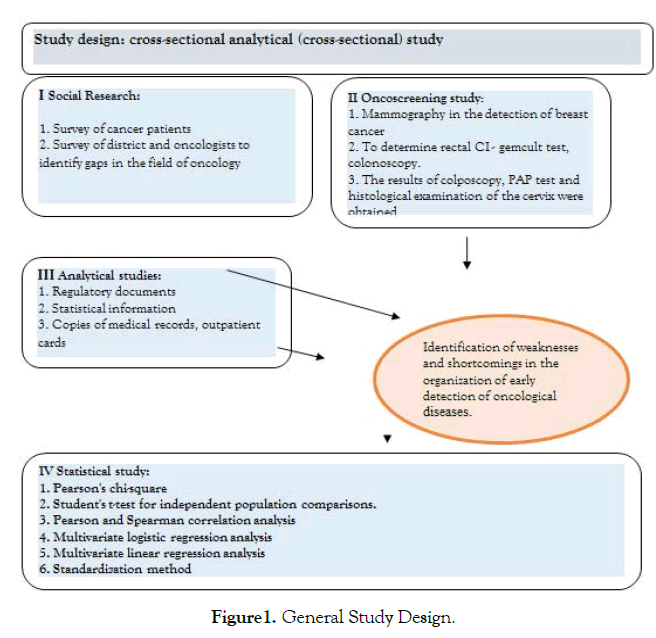
Figure 1. General Study Design.
In modern socio-epidemiological conditions, the main ways to improve the quality of detection and treatment of ED have been identified. During the study, the following data were analyzed: the study of medical care provided to cancer patients, the determination of the state of advanced training of doctors in accordance with the current system of modernization, the study of social aspects of the prevalence of CI in the early detection of oncological diseases, the opinions of patients were analyzed, and methodological approaches were developed. research programs show general oncological and individual characteristics of the disease in patients of working age. The socio-hygienic criteria of various aspects of the lifestyle of patients and the conditions for the formation of the results of their health were studied, on the basis of the questionnaire, the main directions of disability and rehabilitation measures were formed. In the process of modern improvement of onco-screening studies for the early detection of tumor and pre-infarction pathology, the effective implementation of methodological approaches is recommended.
According to the goals and objectives of our research work, the research program consists of 5 stages (Table 1). The objects of study were carried out in accordance with the tasks and deadlines. The study was divided into 3 areas. In the first referral, out of 11,200 patients registered in the general regional oncological dispensary, 5,874 patients were classified as patients of working age, N=1,696 patients were selected. The final sample consisted of 1669 patients, questionnaires of 27 patients who did not fully answer the questions of the questionnaire were not included in the study. The control group included N=1754 able-bodied patients who attended the clinic.
| Research stages | Research work methods | Research sources and unit management | |
|---|---|---|---|
| One | 2 | 3 | |
| Preliminary period | |||
| Literature, normative analysis, literature review. | Analysis | Medical literature (monographs, journals, articles, methodological instructions, tools, scientific articles, abstracts, dissertations, etc). In total, 250 literatures were analyzed, including 150 foreign and 100 domestic ones. |
|
| Stage 1. 2016-2021 Residents of working age in Shymkent, OKOincluding morbidity, disability and death from cancer | |||
| Last in the city OKO Shymkent For 10 years (from 2006 to 2016) morbidity, mortality in oncological institutions, disability analysis. Study population by age groups to determine the features of the level and structure of general morbidity. |
Statistics analysis, data copies |
Data of the Institute of Oncology of the Republic of Kazakhstan. from the dispensary, statistical department – official statistical compilations are final. Analyzed over 10 years (2006-2016) Cancer patients registration details first patients diagnosed repeatedly forms No. 7 and No. 30, No. 90 Copies of forms received. Case history - No. 003 / y, Outpatient clinic from cards No. 025/u, data gathered. |
|
| Phase 2. In the city of OKO Shymkent received cancer and primary diseases CIAnalysis of screening program results for staging | |||
| Cancer screening by CSO analyze the results of the program. Tumors and Tumors with early diagnosis of frontal pathologies reasons for delaying treatment identify negative influences. | Questionnaire | Annual report OKO LLC, city polyclinics information, oncology Conclusion of oncocytological and mammographic screening for women information has been received. Women and conducted for the target group of men. The final data of the hemocult test and colonoscopy were collected. copies of medical records was received (N=15111). |
|
| 3rd stage. The survey was conducted among N=1669 patients. The spread of oncological diseases among the workingage population, the role of influencing factors,identification of risk groups, social aspects | |||
| Age and sex characteristics material and living conditions of cancer patients of working age living conditions; family and work moral and psychological state on the spot; labor activity special attention was paid to its features. Medical literacy; Healthy lifestyle study. | Social statistics people (interview) | Conducted according to research N=1669 patients were selected. | |
| Stage 4. Studying the opinions of medical workers on the organization of oncological care | |||
| 1. The study of the relationship of doctors between medical institutions. 2. To study the opinions of district doctors and oncologists on the organization of the work regime. 3. Evaluation of doctors' knowledge in the oncoscreening system and feedback when organizing a screening program identify key influencing factors. one 3 5th stage. Development of therapeutic, organizational and methodological approaches for the timely detection and treatment of oncological diseases among the working population and improvement of dispensary monitoring of oncological patients. Characteristics of the main organizational and administrative documents regulating the activities of healthcare institutions. 2) Oncology dispensary study of structural and organizational tasks of activity. 3) Studying the timeliness of registering cancer patients for dispensary registration. 4) Timely detection of malignant and precancerous pathology, development of methodological approaches in line with the modern direction of effective oncological screening. Statistics analysis, analysis . researched information . |
Sociologist or (interview) | 500 regional and 40 survey of oncologists was held | |
| 5th stage. Development of therapeutic, organizational and methodological approaches for the timely detection and treatment of oncological diseases among the working population and improvement of dispensary monitoring of oncological patients | |||
| 1. Characteristics of the main organizational and administrative documents regulating the activities of healthcare institutions. 2. Oncology dispensary study of structural and organizational tasks of activity. 3. Studying the timeliness of registering cancer patients for dispensary registration. 4. Timely detection of malignant and precancerous pathology, development of methodological approaches in line with the modern direction of effective oncological screening. |
Statistics analysis, analysis | Researched information | |
Table 1. Stages of the research program.
The second group consisted of N=600 district doctors of district and city polyclinics of the South Kazakhstan region, 100 doctors were excluded from the study due to incomplete answers to the questionnaire. For the study, surveys were taken for a total of N=40 oncologists, mammologists working in district and city polyclinics of the region (Figure 2). The third area of research is the medical records of patients who have undergone oncological screening, as well as medical records with N=15,111 registered medical records in multidisciplinary hospitals over the past 10 years [3].
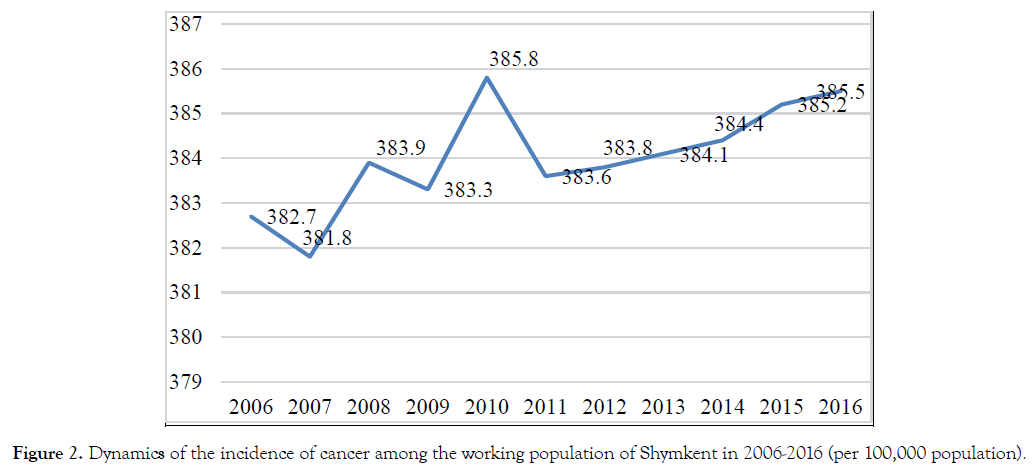
Figure 2. Dynamics of the incidence of cancer among the working population of Shymkent in 2006-2016 (per 100,000 population).
Informed consent to participate in the study was obtained from patients of working age (16-62 years). We processed the core population sample using the Epi Info online calculator. Respondents were excluded from the general study: patients in need of emergency treatment, patients with severe decompensated chronic pathology (patients with III, IV degrees of chronic heart failure), children, pregnant women, residents of other regions. In addition, the sample did not include medical records and cards without detailed information about the patient [4].
Ethical permission to conduct scientific research was received from the ethical committee of the International Kazakh-Turkish University named after Khoja Ahmed Yassaui (Protocol No. 9a dated October 29, 2015). Informed consent to participate in the study was obtained from all respondents. All data was entered into the database in encrypted form.
The calculations were carried out using the MS Excel program on a computer, and the data obtained during the study were subjected to statistical processing using a test version of SPSS (SPSS Inc 17, Chicago, Illinois, USA).
The type of distribution of the total set was checked using the Kolmogorov-Smirnov test for a large sample when describing numerical indicators. As a null hypothesis, we took that the hypothesis under study does not differ from the norm. If the achieved level of significance (p) is less than 0.05, then the null hypothesis is rejected. When studying 2 or more groups, the type of distribution was determined for each group. We used the arithmetic mean (Sr) and Standard Deviation (SD) to describe normally distributed numerical data. The Confidence Interval (CI) for the 95% population mean is also shown. If quantitative data were not normally distributed, the median (Md) was used to describe them, and 95% CI was calculated to estimate the interval of the median [5,6]. percentage frequency and proportions were used. CIs were calculated for the sample mean and the proportion of the sample. A parametric test was used for a normal distribution of data and a nonparametric test for a skewed distribution.
If the data were normally distributed, an unpaired Student's t-test was used to compare the mean in two independent groups [7-9].
Pearson's chi-square test was used to compare nominal data in two independent groups. When comparing qualitative data of 3 or more groups, Pearson's chi-square was used.
To analyze the results of a randomized control trial, multiple linear regression analysis was used, the significance of which was determined using Pearson's chi-square. The unadjusted and adjusted significance of the coefficients and their CIs are shown [11,12].
Oncological morbidity, mortality and disability among able-bodied residents of shymkent
Despite the organization of medical care at a high level, mortality from oncological pathologies in the Republic of Kazakhstan ranks second in the structure of total mortality of the population. Every year, 17 thousand people die from CKD, about 42% of them are patients of working age. For 10 years, according to the statistical summary, the incidence of CKD increases from 361.9 per 100,000 population in 2006 to 409.3 per 100,000 population in 2016. Among them, the prevalence of the disease among residents of Shymkent in 2006 was 606.4 per 100,000 inhabitants, in 2016- 576.1 per 100,000 inhabitants. A high level among the inhabitants of the district was noted in Baidibek district in 2006, when the prevalence of the disease was 272.8 per 100,000 inhabitants, and in 2016 the incidence was 473.1 per 100,000 inhabitants. On the contrary, we found that the lowest rate was registered in Saryagash district in 2006-291.7, and in 2016 it decreased to 278.9 per 100 thousand inhabitants (Table 2).
| No | District and city | 2006 | 2009 | 2012 | 2015 | 2016 |
|---|---|---|---|---|---|---|
| 100 thousand people | 100 thousand people | 100 thousand people | 100 thousand people | 100 thousand people | ||
| one | Aryssky district | 195.8 | 374.6 | 378.0 | 441.6 | 445.4 |
| 2 | Baidibecauda | 272.8 | 274.8 | 282.5 | 461.6 | 473.1 |
| 3 | Kazygurtsky district | 211.2 | 234.5 | 326.9 | 318.6 | 319.1 |
| Four | Makhtaral region | 246.9 | 292.6 | 321.0 | 292.4 | 296.3 |
| 5 | Ordabasy district | 347.4 | 302.4 | 339.1 | 323.5 | 326.1 |
| 6 | Otyrarsky district | 295.6 | 376.4 | 425.4 | 326.6 | 332.2 |
| 7 | Sairam region | 351.6 | 384.0 | 358.5 | 379.3 | 380.2 |
| Eight | Saryagash region | 291.7 | 292.8 | 259.0 | 263.1 | 278.9 |
| 9 | Sozak region | 152.9 | 209.6 | 315.1 | 373.0 | 385.1 |
| Ten | Tolebi district | 429.0 | 409.9 | 478.2 | 432.4 | 456.3 |
| Eleven | Tulkibassky district | 429.0 | 332.6 | 458.9 | 409.5 | 423.1 |
| 12 | Shardara region | 296.9 | 335.9 | 348.4 | 302.3 | 323.1 |
| 13 | City of Kentau | 440.9 | 455.4 | 412.3 | 397.6 | 401.5 |
| Fourteen | Turkestan | 266.6 | 317.6 | 313.6 | 285.8 | 296.3 |
| Fifteen | Shymkent city | 606.4 | 703.0 | 758.1 | 565.1 | 576.1 |
| 16 | All: | 361.9 | 405.0 | 435.1 | 401.3 | 409.3 |
Table 2. Cancer incidence per 100,000 populations over the past 10 years among residents of the South Kazakhstan region.
According to the data presented in fifth one, morbidity and mortality from SCD in the past 10 years prevailed over the following types of cancer. It has been established that the chest, stomach, lungs and skin are in the first place (breast gland 14.5%0000 in women and stomach 9.7%00 in men) in Table 3. Index of general incidence of oncological diseases among residents of working age in Shymkent, 2006-2016. We studied between In the course of the study; we found out that this indicator gives dynamic growth without stopping. In 2006, this figure was 382.7 cases per 100,000 inhabitants, and in 2010 it reached its maximum level (385.8%00 ). In 2010, this figure is really high due to the mass survey of Shymkent residents [13-16]. In recent years (2006-2016), this figure has increased from 382.7%00 to 385.5%00 (Figure 2). The dynamics of the index of the first cases of oncological diseases among residents of working age in Shymkent for 2006-2016 showed that this pathology increased from 197.9%00 to 203.7%00. Its maximum level was determined in 2016, the annual increase is 0.293%00. Compared to this, the incidence of primary cancer increased by 2.9% over the years of the study (Figure 3)( Table 3).
| Place (I to X) |
Localization of cancer | 2006 | 2016 _ _ | ||
|---|---|---|---|---|---|
| Abs. | 100 thousand people | Abs. | 100 thousand people | ||
| I._ _ | All types of cancer | 2003 | 76.9 | 3123 | 109.2 |
| One | Breast | 184 | 9, 3 | 413 | 14.5 _ |
| 2 | Stomach | 165 | 5, 8 | 282 | 9, 7 |
| 3 | Lungs | 122 | 6, 8 | 243 | 8.5 _ |
| Four | Leather | 131 | 5, 6 | 214 | 7.5 _ |
| 5 | esophagus | 109 | 3, 8 | 155 | 5, 5 |
| 6 | Cervix | 153 | 5, 7 | 195 | 6, 9 |
| 7 | Brother | 86 | 3, 9 | 123 | 4, 4 |
| Eight | Anabez | 90 | 2, 4 | 100 | 3, 5 |
| 9 | Bud | 84 | 3, 3 | 87 | 3, 1 |
| Ten | Sex organs | 64 | 2, 7 | 58 | 2, 4 |
Table 3. Presents the most common types of cancer first registered among residents of the city of Shymkent OKO in the period from 2006 to 2016.
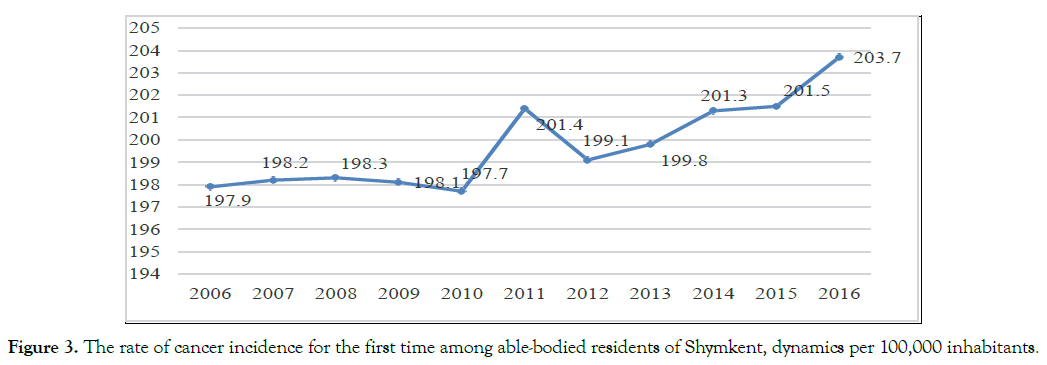
Figure 3. The rate of cancer incidence for the first time among able-bodied residents of Shymkent, dynamics per 100,000 inhabitants.
The approximation method determines the direction of development in the long-term dynamics of the indicator and its annual growth. Determining the direction of development of the indicator and estimating the annual share made it possible to obtain the following result. If the initial hypothetical level of the indicator was 380.5%00, then its final result was 384.9%00. Thus, in the years under study (2006-2016), the level of total cancer incidence increased by 7%00, and its annual increase was 0.438%00 (Figure 4). If we focus on the mortality of the working-age population, then in 2006 this indicator was 199.2 per 100 thousand of the population, and in 2016 it increased to 202.1 per 100 thousand of the population (Figure 5).
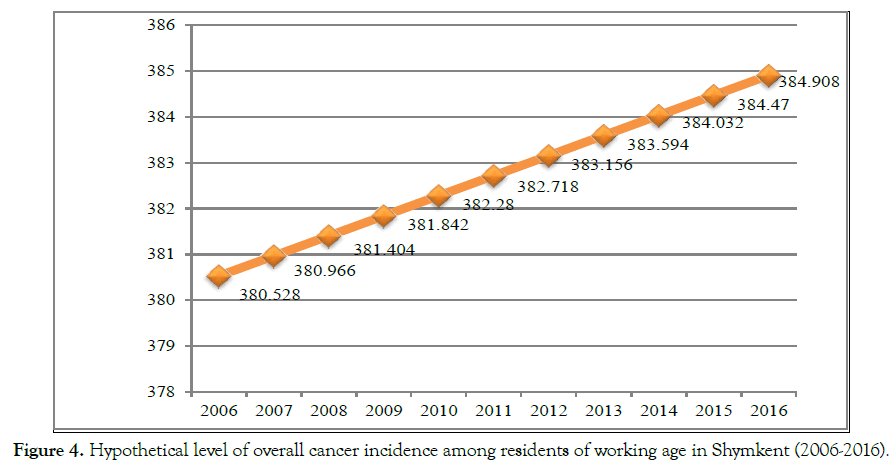
Figure 4. Hypothetical level of overall cancer incidence among residents of working age in Shymkent (2006-2016).
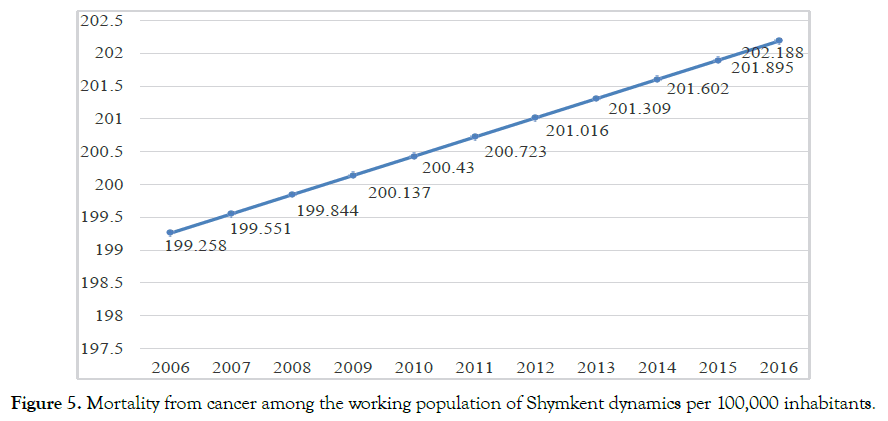
Figure 5. Mortality from cancer among the working population of Shymkent dynamics per 100,000 inhabitants.
First of all, attention is drawn to the prevalence of oncological nosologies identified in these social groups in Shymkent. The reason is that individual nosologies among these pathologies are constantly increasing. The study found that bronchopulmonary cancer is the most common oncological pathology among the working population. Its level was 63.2%00 in 2006, 63.0%00 in 2010 and 62.8%00 in 2016 (Figure 6). The hypothetical growth rate of the indicator was 0.5 percent. In second place gastrointestinal diseases of the stomach. Its level in 2006 was 58.4%00, and in 2016 it was 59.1%00. The level of the indicator increased by 1.2 percent over the years of research. This situation shows that screening and preventive measures are ineffective.
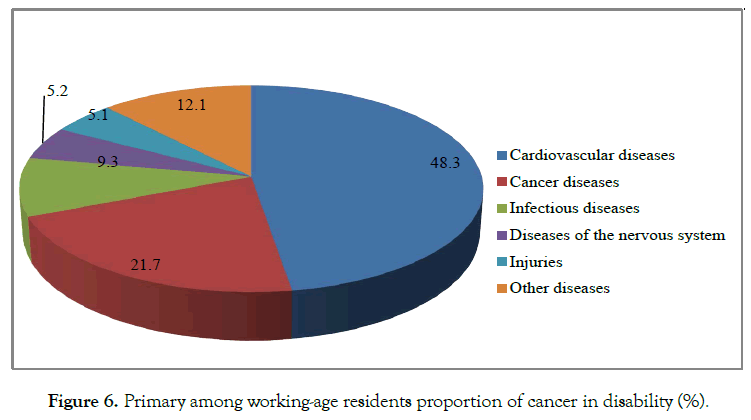
Figure 6. Primary among working-age residents proportion of cancer in disability (%).
Breast cancer is in third place. Over the years of research, its rate has increased to 1.5 percent. Therefore, it is necessary to develop a special program for the early detection of breast cancer among women and create a unified system of social and hygienic control. Esophageal cancer ranks fourth. The initial level of this indicator is 41.2 %00 and the lowest level is 40.1%00. There was a downward trend in the incidence, its hypothetical decrease was 0.3 percent. Rectal cancer occurs at a high level among residents. Its indicator in 2006 was 31.2%00, and in 2016 it reached 31.9%00. Therefore, it is necessary to create conditions for the early detection of these diseases and the timely implementation of preventive measures (Table 4).
| Group of diseases | 2006 | 2008 | 2010 | 2012 | 2014 | 2015 | 2016 |
|---|---|---|---|---|---|---|---|
| 1. Pathologies of the circulatory system | 101.8 | 103.2 | 102.8 | 104.8 | 102.5 | 103.7 | 103 , 1 |
| 2. Cancerous tumors | 70.9 | 41.7 | 71.2 | 72.3 | 41.5 | 71.8 | 72.0 |
| 3. Injury and poisoning | 38.6 | 39.1 | 38.6 | 38.7 | 39.2 | 38.7 | 38.8 |
| Diseases of the digestive system | 12.6 | 1187 | 12.4 | 12.5 | 12.8 | 12.2 | 1 3.9_ |
| 5. Nosology of the respiratory organs _ | 10.3 | 9.9 | 10.2 | 10.1 | 10.4 | 9.9 | 10.2 |
| 6. Infectious diseases | 3.0 | 3.3 | 2.9 | 3.2 | 3.3 | 3.3 | 4 , 1 |
| Conclusion | 237.3 | 238.9 | 237.6 | 241.4 | 240.1 | 240.4 | 240.0 |
Table 4. Mortality of the able-bodied population in Shymkent OKO (per 100,000 population).
Positive changes in the level of development of the indicator can be explained by the introduction of innovative technologies and the high-quality performance of screening work. The increase in the above nosologies shows that it is necessary to pay attention to an increase in clinical examination in order to improve work in this direction.
According to the seventh table, malignant tumors rank second in the mortality of the working-age population. Their level increased by 1.6 percent from 2006 to 2016, from 70.9%00 to 72.0%00. Cardiovascular diseases ranked first with 103.1%00, while injuries and poisoning ranked third with 38.7‰ When calculating %00 and diseases of the respiratory organs (10.2%00 ) formed at a significantly higher level. Infectious diseases rank sixth in mortality and reach 4.1%00. Thus, pathologies of the circulatory system, cancer or oncological diseases are considered as the main cause of death of the working population. The reason for this is that in recent years the incidence of CI has been increasing from year to year (Table 5).
| Warm Age |
City B-village |
2006 | 2010 | 2014 | 2016 | T Student Criteria (2006-2016) |
|---|---|---|---|---|---|---|
| 0-14 years old | BUT | 5.2 ± 1.6 | 1.6 ± 0.7 | 4.3 ± 1.2 | 8.2 ± 1.5 | 1.33 |
| B | 8.2 ± 1.7 | 8.2 ± 1.3 | 5.2 ± 1.6 | 4.5 ± 1.8 | 1.34 | |
| 15-19 years old | BUT | 7.2 ± 3.7 | 3.2 ± 1.7 | 3.7 ± 1.6 | 2.5 ± 1.4 | 1.33 |
| B | 4.5 ± 3.3 | 210 ± 2.1 | 5.4 ± 1.3 | -5.3 ± 1.4 | -0.25 | |
| 20-24 years old | BUT | 9.2 ± 3.4 | 11.3 ± 3.4 | 4.2 ± 1.7 | 10.1 ± 3.2 | 0.21 |
| B | 9.0 ± 4.1 | 6.7 ± 4.7 | 10.1 ± 5.0 | 11.4 ± 6.5 | 0.31 | |
| 25-29 years old | BUT | 13.4 ± 4.5 | 12.0 ± 4.0 | 8.3 ± 2.7 | 8.2 ± 2.5 | 1.02 |
| B | 17.4 ± 5.6 | 8.1 ± 5.7 | 16.4 ± 6.5 | 16.2 ± 6.5 | 0.17 | |
| 30-39 years old | BUT | 40.1 ± 5.7 | 30.4 ± 4.1 | 31.8 ± 4.6 | 39.6 ± 4.2 | 0.04 |
| B | 377.3 ± 6.0 | 31.7 ± 6.9 | 42.8 ± 9.7 | 42.3 ± 7.5 | 0.51 | |
| 40-49 years old | BUT | 158.6 ± 14.6 | 135.8 ± 9.5 | 114.7 ± 7.4 | 124.2 ± 8.6 | 0.61 |
| B | 135.0 ± 13.2 | 123.2 ± 12.0 | 91.8 ± 11.5 | 121.6 ± 17.1, | 0.62 | |
| 50-59 years old | BUT | 344.1 ± 25.2 | 279.6 ± 18.6 | 244.7 ± 14.6 | 240.3 ± 12.7 | 3.68 |
| B | 249.4 ± 19.1 | 237.1 ± 20.0 | 203.5 ± 16.8 | 201.3 ± 19.1 | 0.03 _ _ | |
| People over 60 | BUT | 722.6 ± 49.8 | 586.1 ± 24.5 | 569.8 ± 20.6 | 485.6 ± 19.1 | 0.69 |
| B | 499.1 ± 26.1 | 359.5 ± 21.1 | 371.7 ± 21.1 | 379.1 ± 20.1 | 3.63 |
Table 5. Age mortality rates per 100,000 children among female residents of Shymkent, South Kazakhstan region, district and city (M ± t).
The study of the standardized incidence of CI in women revealed the following features. Among them, breast cancer is in the 1st place (43.2%00 ), and diseases of the female reproductive system (15.2%00) are in the second, third and fourth places. Based on the data obtained, it was shown that the features of women's predisposition to oncological pathologies are primarily localized in the reproductive organs. Therefore, the obstetrician-gynecologist shows that the symptoms of these diseases should be closely monitored. And the level of oncological pathologies that occur in other organs is as follows: colon cancer-11.9%00, respiratory cancer - 3.1‰ 00, pancreatic cancer is formed at the level of 2.7%00. Therefore, it is necessary to carry out preventive measures in accordance with the characteristics of oncological diseases, depending on the sex of the population and the area of residence. Table 5 present the results of 10-year mortality of women and men of different age groups by years. According to Gomperz 's law, mortality increases in women at the age of 20-24 years (15.4), and in men, cancer begins at the age of 30-34 years (16.3). Depending on sex, the mortality rate is 17.1 per 100,000 of the population aged 30-39 to 40-49, that is, among citizens of working age. And the mortality rate between the ages of 50-59 and 60 affected the majority of rural residents (p>0.05). Moreover, mortality among women showed an annual decline in all age groups, and it is noteworthy that mortality among urban residents aged 40-49 and 50-59 years is higher than among rural residents. The intensity of mortality between the age groups of women and men in the period from 2006 to 2016 decreased slightly between the ages of 50-59 and 60 years. And among other age groups, this is a normal level according to normative indicators (Table 6).
| Warm Age |
City B-village |
2006 | 2010 | 2014 | 2016 | t Student Criteria (2006-2016) |
|---|---|---|---|---|---|---|
| 0-14 years old | BUT | 8.0 ± 3.4 | 3.1 ± 2.1 | 11.1 ± 1.9 | 6.5 ± 2.8 | 0.8 |
| B | 6.8 ± 2.0 | 5.6 ± 1.9 | 4.1 ± 3.1 | 10.1 ± 3.1 | 0.5 | |
| 15-19 years old | BUT | 5.0 ± 3.0 | 11.9 ± 4.3 | 5.8 ± 1.3 | 7.3 ± 2.1 | 0.77 |
| B | 14.1 ± 4.6 | 9.1 ± 2.9 | 11.9 ± 6.1 | 15.2 ± 5.4 | 0.07 | |
| 20-24 years old | BUT | 9.6 ± 2.9 | 5.1 ± 3.1 | 9.1 ± 3.1 | 2.6 ± 2.8 | 1.83 |
| B | 14.9 ± 4.0 | 7.6 ± 4.9 | 9.0 ± 3.9 | 16.7 ± 6.3 | 0.06 | |
| 25-29 years old | BUT | 16.2 ± 3.8 | 17.1 ± 3.9 | 12.1 ± 2.9 | 14.4 ± 2.4 | 0.53 |
| B | 16.9 ± 6.1 | 17.9 ± 9.6 | 22.9 ± 6.9 | 12.1 ± 3.6 | 0.71 | |
| 30-39 years old | BUT | 62.3 ± 3.1 | 58.6 ± 2.1 | 51.9 ± 3.9 | 43.5 ± 4.5 | 1.33 |
| B | 51.1 ± 5.1 | 44.1 ± 6.9 | 40.2 ± 9.1 | 38.8 ± 5.9 | 0.72 | |
| 40-49 years old | BUT | 178.2 ± 16.1 | 149.1 ± 10.9 | 148.1 ± 8.9 | 169.0 ± 11.5 | 0.27 |
| B | 142.6 ± 15.7 | 149.1 ± 13.5 | 163.8 ± 14.3 | 149.7 ± 16.9 | 0.21 | |
| 50-59 years old | BUT | 476.8 ± 29.9 | 553.6 ± 32.3 | 539.9 ± 33.7 | 527.6 ± 19.9 | 0.19 |
| B | 461.0 ± 29.9 | 461.7 ± 37.4 | 459.6 ± 31.9 | 452.9 ± 39.6 | 0 , 0 5 | |
| Over 60 years old | BUT | 1399.4 ± 71.6 | 1451.4 ± 49.7 | 1431.6 ± 48.6 | 1273.0 ± 27.5 | 1.38 |
| B | 1228.9 ± 54.5 | 1174.5 ± 61.7 | 1112.1 ± 53.8 | 1154.2 ± 39.7 | 2.39 |
Table 6. Age indicators of mortality of men in the South Kazakhstan region and the city of Shymkent per 100,000 population (M ± t).
One of the main indicators of social and hygienic significance in the healthcare system is the characteristic of the formation of primary disability [17-20]. In our study, the share of oncological diseases in primary disability among the working-age population was determined. Oncological diseases rank second in terms of primary disability and its share reaches 21.7%, and the proportion of patients of working age is 10.3% (Figure 7). The study of the standardized incidence of Shymkent residents by gender revealed the following patterns. If we classify oncological diseases according to the nosology that occurs in men, then 51.2% of them were broncho-pulmonary.
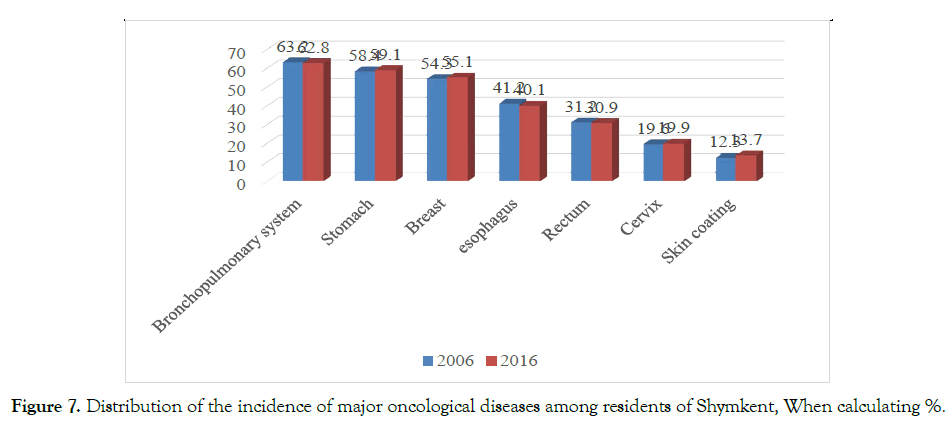
Figure 7. Distribution of the incidence of major oncological diseases among residents of Shymkent, When calculating %.
Gastric cancer was formed in 25.8%. Esophageal cancer occurs in 19.1%, skin cancer in 17.5%. Colon and rectal cancer accounted for 16.1% and liver cancer for 14.7% (Figure 8). According to the results of the standardized index of the incidence of women with oncological diseases, the following phenomena were revealed. 1st place - breast cancer 43.2%00, 2-3-4th place-cancer of the reproductive organs of women 15.2%00. Based on the results obtained, it is shown that the reproductive organs are in 1st place in terms of the impact on women of exposure to STIs of the disease.
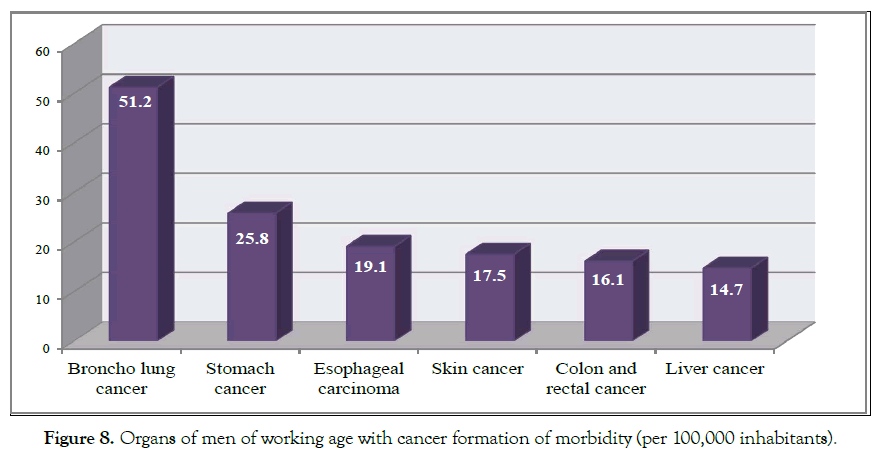
Figure 8. Organs of men of working age with cancer formation of morbidity (per 100,000 inhabitants).
In this regard, the obstetrician explains to gynecologists that the symptoms of this disease must be strictly controlled. And the level of oncological conditions that occur in other organs is 11.9%00 of the lower threshold, 3.1%00 of the respiratory system, and 2.7%00 of the pancreas. Therefore, it is necessary to carry out dispensary activities for the prevention of CKD diseases for specific types of oncological pathology, formed depending on the age group and gender of the population and the place of residence of the population in (Figures 8 and 9).
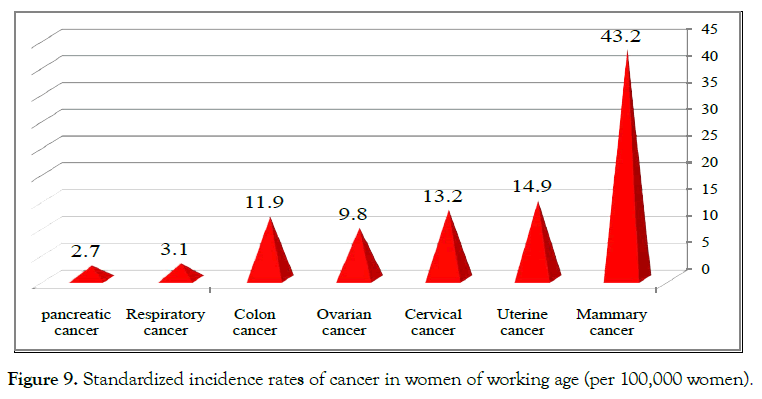
Figure 9. Standardized incidence rates of cancer in women of working age (per 100,000 women).
In this regard, the obstetrician explains to gynecologists that the symptoms of this disease must be strictly controlled. And the level of oncological conditions that occur in other organs is 11.9‰00 of the lower threshold, 3.1%00 of the respiratory system, and 2.7%00 of the pancreas [21-23]. Therefore, it is necessary to carry out dispensary activities for the prevention of CKD diseases for specific types of oncological pathology [24-29], formed depending on the age group and gender of the population and the place of residence of the population (Figure 9).
Based on the results obtained, it can be said that preventive and therapeutic measures are ineffective. There is reason to believe that this situation is due to the lack of timely detection of oncological diseases, the low quality of their diagnosis, and the weak fight against malignant causes. In order to correct this situation, first of all, the need to identify oncological pathologies at an early stage and ensure high-quality and complete treatment of precancerous diseases should become the scientific basis for cancer prevention programs.
Indexed at, Google Scholar, Cross Ref
Indexed at, Google Scholar, Cross Ref
Indexed at, Google Scholar, Cross Ref
Indexed at, Google Scholar, Cross Ref
Indexed at, Google Scholar, Cross Ref
Indexed at, Google Scholar, Cross Ref
Indexed at, Google Scholar, Cross Ref
Indexed at, Google Scholar, Cross Ref
Indexed at, Google Scholar, Cross Ref
Indexed at, Google Scholar, Cross Ref
Indexed at, Google Scholar, Cross Ref
Indexed at, Google Scholar, Cross Ref
Citation: Tazhibayeva KN, Sadykova AD, Kaldygozova GE, Ormanov AN, Daurenov BB, Kuliev AF, et al. (2022) Epidemiology of Visual Cancer and Determination of the Incidence in the Working-Age Population. J Women's Health Care 11(12):615.
Received: 21-Nov-2022, Manuscript No. JWH-22-20345; Editor assigned: 22-Nov-2022, Pre QC No. JWH-22-20345 (PQ); Reviewed: 06-Dec-2022, QC No. JWH-22-20345; Revised: 11-Dec-2023, Manuscript No. JWH-22-20345(R); Published: 17-Dec-2022 , DOI: 10.35248/2167-0420.22.11.615
Copyright: © 2022 Tazhibayeva KN, et al. This is an open-access article distributed under the terms of the Creative Commons Attribution License, which permits unrestricted use, distribution, and reproduction in any medium, provided the original author and source are credited